|
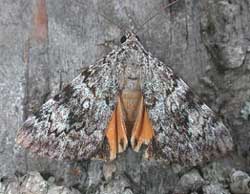
| **8878 Catocala amica;
Girlfriend; wingspan: 35-40mm
|
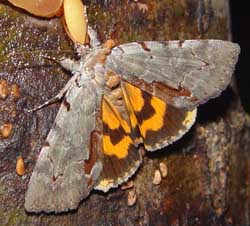
| ** 8864 Catocala grynea ; Woody Underwing, 40-50mm:
The forewing is a dull greenish grey with orangey-brown shading along
the inner margin. The antemedial, median and postmedial lines are
quite faint.
Praeclara is somewhat similar but has a break in the brown shading
between the am and pm lines. Praeclara also has a paler orange
hindwing color. |
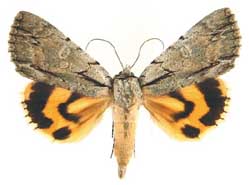
| ** 8772 clintoni; Clinton's Underwing, wingspan 45-55mm.The black basal dash distinguishes clintoni from illecta and abbreviatella, both of which lack the dash. Vernon Brou image. |
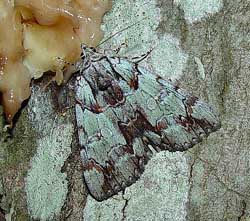
| ** 8865 praeclara; Praeclara Underwing, (40-50mm); The forewing is a pale greenish-grey with considerable contrasting brown shading beyond post medial line.There is a black basal dash very close to the inner margin and another dash, higher up in the median area. Note the contrasting shapes of the reniform and subreniform spots. subspecies manitoba Tim Dyson image. |
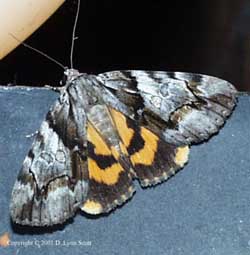
| ** 8867 Catocala blandula;
Charming Underwing, wingspan: 40-50mm. |
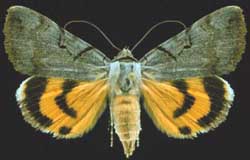
| ** 8841 Catocala abbreviatella; Abbreviated Underwing; 40-50mm. Fw uniformly colored with narrow black lines on anterior half. Brown reniform spot ringed with black. Outer black band of hw abbreviated, then a dot. Inner black band terminates well before im. Similar species: Catocala nuptialis, solid black reniform spot. C. whitneyi, broad dark triangles mid fw. |
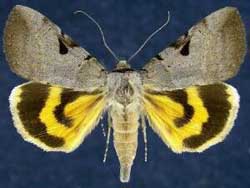
| ** 8858 Catocala nuptialis TM; Married Underwing, wingspan: 40-50mm
The reniform spot is very dark, black or almost black on an otherwise faintly marked, almost uniformly grey forewing.
The outer black margin of the hindwing is unbroken, but is indented near the anal angle. |
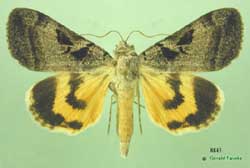
| ** 8843 whitneyi; Whitney's Underwing; 43-50mm. Catocala whitneyi is similar to abbreviatella Grote, and nuptialis Walker, but generally flies later in the season where the species overlap. The two black wedges/triangles on the forewing, one over the reniform spot and the other just outside the antemedial line, distinguish whitneyi. Gerald Fauske image. |
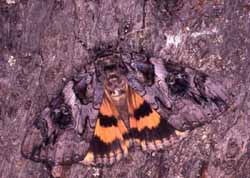 |
** 8844 amestris; Three-staff Underwing; wingspan 43-50mm.There is a large pale patch near the apex. In form "westcotti" the hindwing outer black band is complete. In other moths, the band is broken as in abbreviatella. Hindwing ground colour is usually deeper yellow-orange than in similar species. Leroy Simon image. |
Midsized Orange-Salmon-Red-Scarlet Underwings: Wingspans: 50-72mm
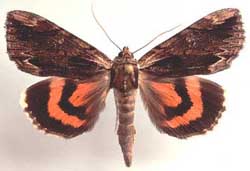
| ** 8857 Catocala ultronia; Ultronia Underwing, wingspan: 50-63mm.Fws typically gray-brown, with a distinct and very dark inner margin and characteristic light brown patch, underscored by very dark arc, near wingtip. Underwings can be yellow to orange to salmon. |
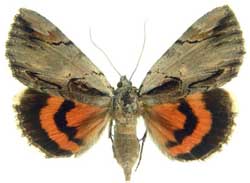
| ** 8857 Catocala ultronia form lucinda; Ultronia Underwing, wingspan: 50-63mm.In form lucinda most of the forewing is bright grey. On all forms there is
extensive orange-salmon colouration on hw ventral surface,
and there is a dark discal lunule. |
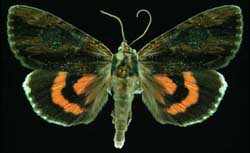
| Catocala ultronia, form nigrescens, the Ultronia Underwing, wingspan: 50-63mm. In the melanic form nigrescens, the dorsal forewing is very dark. Even darker subapical arc, basal dash and dash near anal angle are still visible. Dark basal hairs on hindwing. Harold J. Vermes slide, used with permission from his son. |
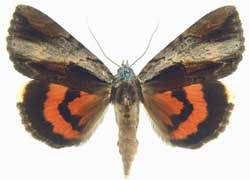
| Catocala ultronia form celia.
In form celia there is a wide, light grey band separating a dark region along inner margin and
a dark patch near the apex.
The ventral surface of forewings of all forms has a generous suffusion
of orange-salmon scales in the lower half of the median area. |
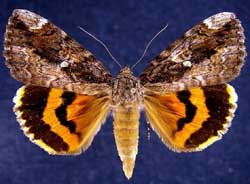
| ** 8770 Catocala innubens; Betrothed; 55-72mm. Forewing is mottled with white, grey and brown, and subrenifrom spot tends to be lighter in colour, although it is sometimes obscured by an indistinct blackish bar which runs from middle of basal/thorax connection to just below much lighter apex at outer margin.Jim Vargo image. |
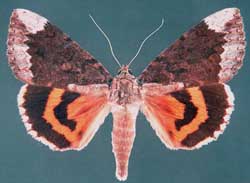
| ** 8770 Catocala innubens form scintillans; Betrothed; 55-72mm.In form scintillans most of the basal area (all but lower third) and all of the median area of the forewing is dark reddish brown. The area outside the pm line is grey. Vernon A Brou image. |
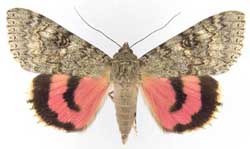
| Catocala hermia; Hermia Underwing: 58-68mm; pinkish: Fw almost uniform, grey-brown or clay coloured; thin, yet contrasting lines. Distinct large double reniform spot. Large concolourous subrenifrom spot usually open. Hw pinkish red, relatively even, narrow black bands. Inner black band ends before im. Fringe white, checked, pink/red "bleeding" along outer band, near apex. |
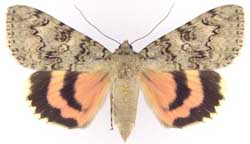
| ** 8808 luciana; Luciana Underwing, 57-68mm. Pale grey brown forewing with very distinct am & postmedial lines. Subreniform spot has elongated narrow "tail" that seems to open through postmedial line. Inner black band of hw does not reach inner margin. Fringe is checked and paler (almost yellow) than salmon ground colour. |
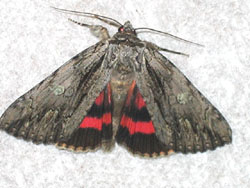
| ** 8851 Catocala coccinata; Scarlet; 57-70mm: Diffuse basal, anal dashes on otherwise light grey, mottled fw. Hw fringe white (often with some salmon scaling), heavily checked. "Tooth" just below pair of very elongated "teeth" is much reduced, quite rounded, usually allowing considerable room for lighter patch of scales. Dark bar crosses thorax. Reniform spot: light, often with greenish cast. Joe Garris image. |
Solid Black Underwings
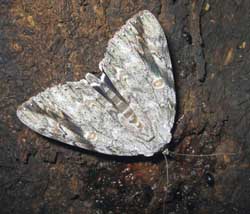
| ** 8793 Catocala maestosa, Sad Underwing, wingspan: 78-98mm. Maesotsa is quite similar to, although usually larger than, vidua. Both have the dark arc from the costa, above the reniform spot, to the outer margin just below the apex. Maesotsa, however, lacks the dark bar, found on vidua, parallel to the inner margin. The reniform spot is brown and there is brown shading just outside the postmedial line. The hindwing fringe is white, narrow and heavily barred. |
Large Black Underwings (Banded): Wingspans: 70-80mm
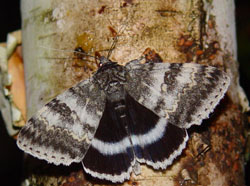
| ** 8803 Catocala relicta
;
Forsaken, White, Relict; 70-80mm:
Considerable variation with regard to black/white
concentrations on fws. |
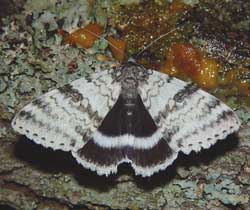
| ** 8803 Catocala relicta ; Forsaken, White, Relict; 70-80mm: Considerable variation with regard to black/white concentrations on fws. Form clara: basal and subterminal areas predominantly white.Typical specimens have basal and subterminal areas with blackish scales. Black hws, with brilliant even white inner band and white fringe, are distinctive. June until October. |
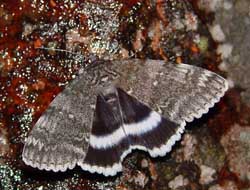
| ** 8803 Catocala relicta ; Forsaken, White, Relict; 70-80mm: Considerable variation with regard to black/white concentrations on fws. Form phrynia: evenly dusted with grey over entire forewing. Typical specimens have basal and subterminal areas with blackish scales. Black hws, with brilliant even white inner band and white fringe, are distinctive. June until October, poplars and willows |
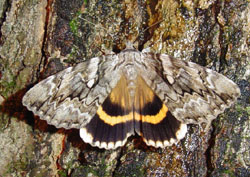
| ** 8802 Catocala cerogama; Yellow-Banded; 70-80mm. Several different forms. Pm line distinct, dark and has elongate pair of projections. Pm and am lines meet inner margin in relative proximity. Closed subreniform spot lighter than surrounding areas, shaped a bit like an arrowhead with point toward body. Hws are distinctive. Jean-Benoît Duval image. |
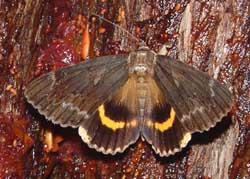
| ** 8802 Catocala cerogama; Yellow-Banded; 70-80mm.Form ruperti: Forewings are almost uniform grey-brown with white scales outlining subterminal line. The hindwings are distinctive. Tim Dyson image. |
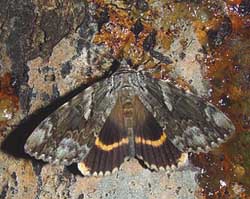
| ** 8802 Catocala cerogama; Yellow-Banded; 70-80mm.Form bunkeri: Forewings are dark in median and basal areas. Hw golden band is reduced in thickness. Basal hairs are brown instead of yellow. The hindwings are distinctive. Tim Dyson image. |
Medium-Large Orange-Salmon Underwings: Wingspans: 60mm, usually 70-95mm
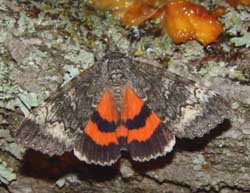
| #8817 briseis; Briseis Underwing; 60-70mm; Fws predominantly mottled dark-grey-brown with some lighter areas 1) between postmedial & subterminal lines, 2) at base of am & pm lines along inner margin, 3) over subreniform spot running diagonally toward costa. Pm lines do not have greatly elongated and sharly pointed "teeth" near apex. Hw fringe white & unbroken, inner black band (fairly even) reaches inner margin. Tim Dyson image. |
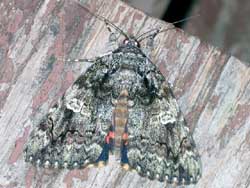
| ** 8801 Catocala ilia; Ilia; wingspan: 65-82mm. Several different forms, most have characteristic white area in and around reniform spot. Diffuse dark arc running from this spot to just below apex. Subreniform spot squarish, concave inner and outer edges and elongated constriction connecting it to pml. White dots near fw om in character with the overall "contrasting" appearance. |
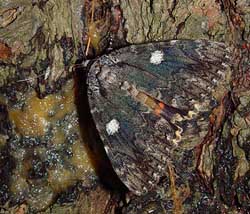
| ** 8801 Catocala ilia; Ilia; form conspicuaIn this form the entire reniform spot is heavily suffused with white scaling on an otherwise darker ground colour. Hence the form name "conspicua". Tim Dyson image. |
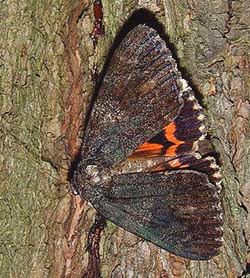
| ** 8801 Catocala ilia; Ilia; form satanasIn this melanic form the entire forewing, including the reniform spot is very dark. Hence the form name "satanas". The dark basal streak is still evident on this form. Tim Dyson image. |
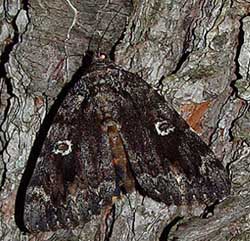
| ** 8801 Catocala ilia; Ilia; form normaniIn this semi-melanic form the entire forewing, excluding the reniform spot, is relatively dark. The brownish, kidney-shaped center of the reniform spot is outlined in white. The basal streak and subapical arc are still visible. Tim Dyson image. |
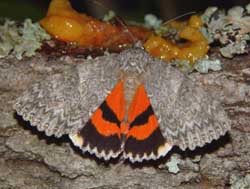
| ** 8822 meskei TM; Meske's Underwing; 65-75mm. Fws less distinctly marked compared to unijuga, some red-orange at the hindwing apex and just inside the fringe along the outer margin in meskei that is lacking in unijuga. Fw subreniform spot is opened or connected to the postmedian line. The hindwing postmedian band nearly straight, turned in and tapering near anal angle. Tim Dyson image. |
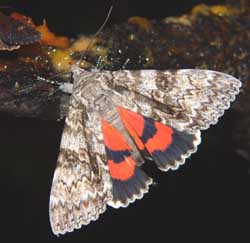
| ** 8821 semirelicta; Semirelict Underwing; wingspan: 65-75mm. Fw ground colour white with dark lines and shadings. Diffuse dark bar runs from center of basal area to outer margin a few mm above anal angle. Note regular dentation of st line. Inner black bar on lower wing usually terminates well before inner margin. The form "atala" has forewing that is uniformly grey. Unijuga is usually larger and has less contrasting black lines. Inner black bar on unijuga usually reaches inner margin. Tim Dyson image. |
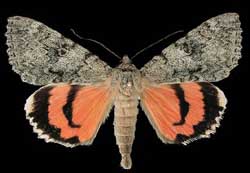
| Catocala junctura; Joined Underwing; 67-85mm. Fw is usually dark brownish-gray to evenly powdered blue-grey w/o significant markings. Doubled reniform spot often obscure. Thin, slightly darker am and pm lines run from costa to im, not widely spaced at im. Hw salmon/ orange-pink, narrow inner black band turns in sharply, does not meet dark-haired im. |
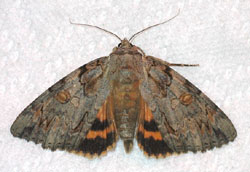
| ** 8798 Catocala neogama; wingspan 70-85mm. Brown head, thorax, larger size as compared to C. palaeogama. Neogama tend to be slightly smaller than subnata, have darker grey brown fws with more pronounced markings. Examination of hind tibia needed for id. Neogama's: flattened, unevenly, sparsely spined; subnata's: cylindrical, spines dense, uniform in distribution. Joe Garris photo. |
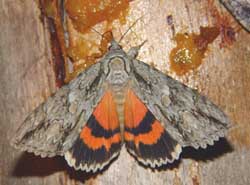
| ** 8806 Catocala parta; Mother Underwing, wingspan: 70-85mm. The black dashes in the basal, subapical and anal areas help to identify this species. The hindwings may be yellow to yellowish-orange but more often are salmon-red. Note the face-head-like markings on the thorax. In the hindwing, the first (nearest the apex) black protrusion into the white fringe is "noticeably" larger than the others. |
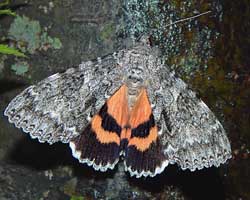
| ** 8805 unijuga; Once-married; wingspan: 70-90mm: Catocala unijuga has a fairly wide black inner band (almost reaching inner margin) in hindwing and very distinctive patterning in forewing. Meskei tend to have narrower band and dustier (less distinct) looking forewing. Semirelicta tend to have inner bands that terminate well before inner margins. Also note the very white fringe on both the forewings and hindwings. Carroll Rudy image. |
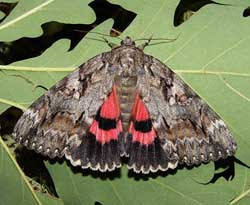
| aholibah; 80-90mm: Fw is mix of grey and brown, with preponderance of brown in subterminal area. Double reniform spot has diffuse brown outline of inner oval. Subreniform spot is small, distinctly outlined in black, light coloured and does not connect to pm line. Upper two teeth of pm line are elongate and are followed by relatively smooth line til next tooth below the subreniform spot. Hindwing salmon or pinkish. |
Medium-Large Pink Underwings: Wingspans: 70-95mm
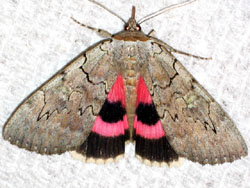
| ** 8833 concumbens Sleepy Underwing or Pink Underwing, 60-75mm). This brown thoracic collar is quite evident in this image as is the interruption in the pm line by the open subreniform spot.The white hindwing fringe is only lightly checked on the wing veins. The vibrant pink bans are distinct in colour and also in their relatively smooth contour. |
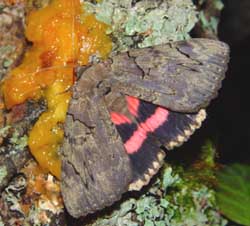
| ** 8832 Catocala cara;
Darling; 70-85mm.
Note deep maroon almost purple cast to fws, mixed with
very pale green. Lower half of am & pm lines is barely
visible. There are no distinctive bars or dashes. The two upper
"teeth" on the pm line are thin and long. |

